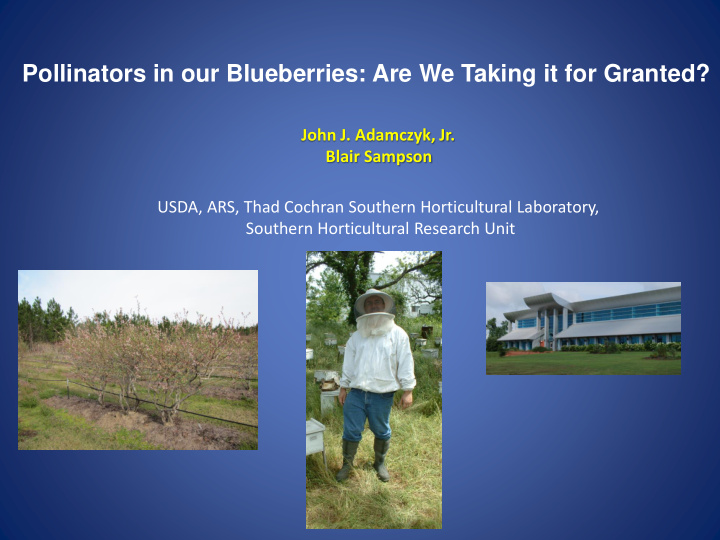



Pollinators in our Blueberries: Are We Taking it for Granted? John J. Adamczyk, Jr. Blair Sampson USDA, ARS, Thad Cochran Southern Horticultural Laboratory, Southern Horticultural Research Unit
Blueberry Pollinating Fact Sheet • A single blueberry plant produces thousands of flower buds every year! • Up to 16 individual flowers from each bud with each flower a potential berry • Pollen from the anthers much reach the stigma so an ovule can be fertilized and develop within the ovary • Dozens of developing seeds inside each berry need to be fertilized in order to develop normally • For a number of reasons, in order to set fruit, the flowers of a blueberry plant must be pollinated by insects * Many points taken from NCSU Extension Service.
Southeastern Blueberry Bee, Hapropoda laboriosa • Most Common Pollinator in our Blueberry Fields • Sonicate or buzz pollinate • May specialize on blueberries, but may not be the most efficient pollinator with respect to single visit efficiency
Southeastern Blueberry Bee
Southeastern Blueberry Bee
Bombus sp. queen on blueberry flower Bombus bimaculatus (native species) Bombus impatiens (imported species) • Can be active in adverse weather conditions • Can produce more seeds than other pollinators • Sonicate flowers, which may increase pollination
Bumble Bee Quads
The Honey Bee, Apis mellifera • “legitimately” forages for blueberry nectar and pollen through the opening at the apex of flowers • managed hive rates of 1-4 per acre of blueberries • honey bees may also take advantage of slits made by carpenter bees to feed on nectar (some pollination) • relatively low single visit pollinating success (i.e. develop into viable seed)
Male Carpenter Bee Robbing Blueberry Flower
Honey Bee Robbing Blueberry Flower via Carpenter Bee Robbery Holes
Osmia ribifloris , manageable blueberry pollinator, not yet available
Do not apply this product while bees are foraging. Do not apply this product until flowering is complete and all petals have fallen unless one of the following conditions is met: “The Label is the Law” Scott Stewart, UT Extension
The application is made to the target site after sunset The application is made to the target site when temperatures are below 55˚F The application is made in accordance with a government- initiated public health response The application is made due to an imminent threat of significant crop loss, and a documented determination consistent with an IPM plan or predetermined economic threshold is met. Every effort should be made to notify beekeepers no less than 48- hours prior to the time of the planned application so that the bees can be removed, covered or otherwise protected prior to spraying. “The Label is the Law” Scott Stewart, UT Extension
“Bee Awareness” Programs Mississippi, Louisiana, Arkansas, Tennessee, etc. Voluntary agreement between stakeholder groups • B eekeepers • Growers • A pplicators • R egulatory authorities Communication and common sense Scott Stewart, UT Extension
Questions?
Recommend
More recommend